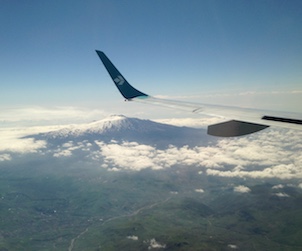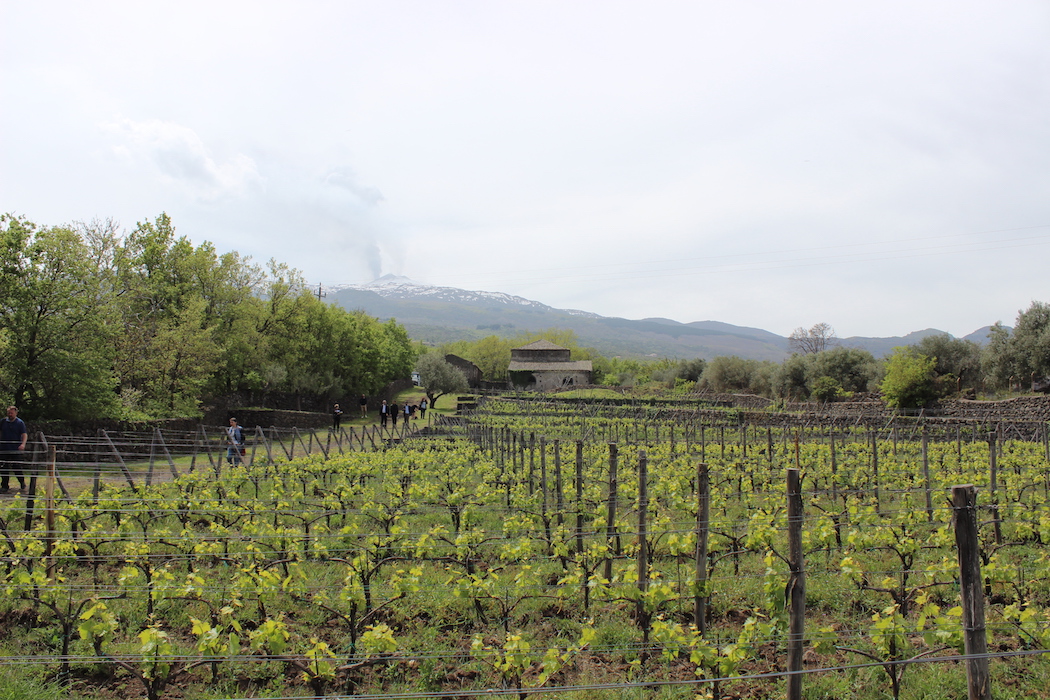Malcolm Jolley on Italy’s hottest, coolest, highest, new and ancient wine region.
The first palmento I saw was at Tenuta di Fessina, up on the North Side of Mount Etna. Fessina is an old house and farm complex, built in the 17th century and recently revived by Tuscan wine doyen Silvia Maestrelli of Villa Petriolo. I assumed the palmento, the house, which was a careful reconstruction, was a unique window into Sicily’s wine making past, with areas for crushing grapes, giant wood press and stone fermentation “tanks”. I assumed wrong, as out of the seven wineries I visited on Mount Etna recently, as a guest of Assovini Sicilia, only one housed in a very modern building didn’t have a palmento to display*, often finding new purpose as a tasting room.
So, why are there so many palmenti, that have been so well preserved among the wineries and farms on Mount Etna? The answer goes back to the turn of the last century, when most of these facilities were built. The phylloxera plague arrived in Italy, from France and began working its way down the peninsula decimating Italian vines. While the French could rely on help from their vineyards in Algeria, as they tore old vines and planted new phylloxera resistant American root stalk, the Italians could only replace with Southern ones as the bug spread down, eventually coming to Sicily. But then, something amazing happened on Mount Etna. The light, black volcanic soil on Etna repelled the phylloxera bug, and Mount Etna experienced something of a “wine rush” as demand for it’s wine began to skyrocket. For a few decades Mount Etna was one of Italy’s biggest sources of wine. It was great until the new vines in Piedmont and Tuscany and Campania, and Marsala, grew back and began to produce wine. The boom had gone bust and by the 1930’s two generations worth of decline took hold.

At Firriato’s Cavanera Etna, vines over 100 years old are tagged by researchers at the University of Palermo.
Michele Faro, at Pietradolce, told me and the small group of Italian and international journalists I traveled with, that when he was young Mount Etna was “the place you went to visit your grandparents”. He was describing the rural depopulation and migration to larger towns, like Catania or Palermo, or north to the big centres like Rome or Milan (or Toronto). His only family, from near Passopisciaro, was as representative of this as any (more on this to come). Vineyards were abandoned and switched to other crops, if they were farmed at all. Whatever wine production was left was either for family consumption or sold to a few small cooperatives.
It’s not until the turn of our century that things began to change. One of the advantages of Mount Etna’s period of neglect was that not much changed in the fields. Old Nerello Mascalese, Nerello Capuccio and white Carricante bush vines, which are held up by a single chestnut wood stake, were left to grow in their traditional goblet shape. It’s not uncommon to find parcels on Mount Etna planted with vines that are over 100 years old. While it’s against the law to replant with European root stalk, the old vines are some of the last examples of them around.
While the way of growing grapes hadn’t changed on Mount Etna for more than a 100 years, the market place for wine certainly did. Etna pioneers like Michele Faro, or the oenologist Salvo Foti, saw the potential of the mountain’s cool climate. At 800 to 1,000 meters high, Etna’s vines make wines with characteristics closer to those of Burgundy than just about any other Mediterranean region. The dominant red grape, Nerello Mascalase makes wines that are sometimes described as a cross between Pinot Noir and Piedmont’s Nebbiolo. Then there is the volcanic soil, which give the light reds and steely whites strong acidity and that elusive (and controversial) characteristic of minerality. By the early 2000’s, these were the sort of wines that discriminating international consumers increasingly wanted to drink, and they were willing to pay a premium for them.
After 15 years since the Mount Etna renaissance began, many others have joined the Faro’s and Foti’s, from grower turned estate winemaker Guiseppe Russo at Girolamo Russo, to big Sicilian producers from the West of the island like Planeta and Tasca D’Almerita. If there was any doubt that Mount Etna is experiencing a second wine rush right now, it was extinguished when Piedmontese superstar vigneron Angelo Gaja announced he was entering a partnership with the Etna house of Graci at the end of April of this year.
I was fortunate enough to meet some of the amazing people making amazing wine on Mount Etna over the few days I visited. My next post will introduce them and what they do.
*This was actually made up for by another winery, Tascante, which had two. And to be fair, it’s entirely possibly, even likely, that Pietradolce does have palmento somewhere on their property that just wasn’t part of our tour.










